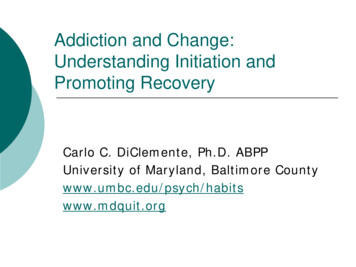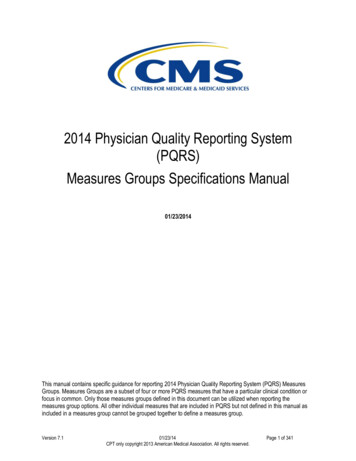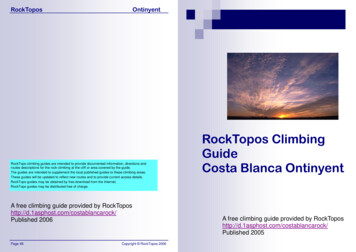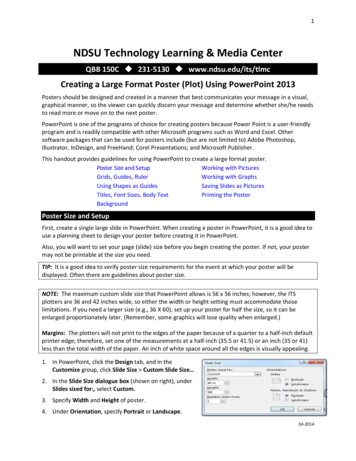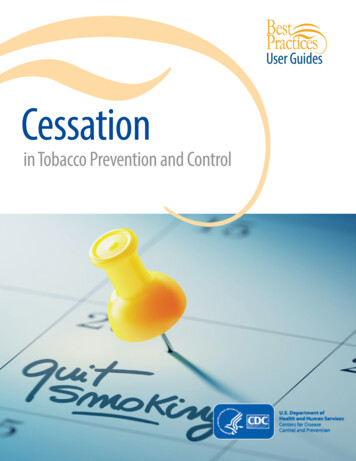
Transcription
Cessationin Tobacco Prevention and Control
AcknowledgementsThis guide was produced for the Centers for Disease Control and Prevention by the Center for PublicHealth Systems Science at the Brown School at Washington University in St. Louis.Primary contributors:Stephanie Andersen, Laura Brossart, Amy Endrizal, Isaiah Zoschke, Rachel Hackett, Rebecca Ballard, Douglas LukeInput was provided by:Rob Adsit, Stephen Babb, Brian King, Michon Mabry, Catherine Saucedo, Anna Schecter, Karla S. Sneegas, BrennaVanFrank, Renee WrightInput for the case studies was provided by:Christin M. Kirchenbauer, Oklahoma State Department of HealthEric Finley, Oklahoma Hospital AssociationDana McCants Derisier, Rhode Island Tobacco Control ProgramOther contributions:Photograph on page 14 courtesy of the California Department of Public HealthPhotographs on page 20 courtesy of Oklahoma Tobacco Settlement Endowment TrustPhotograph on page 26 courtesy of the University of Wisconsin Center for Tobacco Research and Intervention(UW-CTRI)Photographs on page 28 courtesy of Tobacco Free FloridaPhotograph on page 31 courtesy of the New York City Department of Health and Mental HygienePhotograph on page 36 courtesy of ClearWay MinnesotaPhotograph on page 42 courtesy of the New York State Department of HealthPhotograph on page 49 courtesy of the Rhode Island Department of Health
Table of ContentsGuide to the Reader 1Making the Case for Cessation 2Brief History 3How To 4Understanding Cessation Interventions 4Getting Started 8Promoting Health Systems Change 11Improving Cessation Coverage 20Supporting State Quitlines 27Reducing Tobacco-Related Disparities 33Evaluating Cessation Interventions 38Sustaining Cessation Interventions 42Providing Support 45Case Studies 46Case for Investment 50Resources 52References 62
GUIDE TO THE READERPurposeThe Center for Public Health Systems Science atWashington University in St. Louis is developing aset of user guides funded by the Centers for DiseaseControl and Prevention (CDC), contract 200-201587568, for the Best Practices for ComprehensiveTobacco Control Programs—2014 (Best Practices2014), an evidence-based tool to help states developand sustain comprehensive tobacco control programs.The purpose of the user guides is to help tobaccocontrol staff and partners implement evidence-basedbest practices by translating research into practicalguidance. The guides focus on strategies (e.g., programsand interventions) that have shown strong or promisingevidence of effectiveness. Recommendations in thisguide are suggestions for programs helping people quittobacco. Programs can follow these recommendationsaccording to their needs, goals, and capacity. In theuser guides, tobacco refers to the use of manufactured,commercial tobacco products.ContentThis user guide focuses on how comprehensive tobaccocontrol programs can promote cessation throughpopulation-wide efforts. According to Best Practices2014, “encouraging and helping tobacco users to quitis the quickest approach to reducing tobacco-relateddisease, death, and healthcare costs.”1 Populationbased interventions can dramatically increase access toproven cessation treatment and help more people quitfor good. This guide offers program staff and partnersinformation on how to promote health systems change,improve insurance coverage for cessation treatment,and support state quitlines.Links to More InformationEach instance of italicized, bolded blue text in theguide indicates a link to an additional resource or apage within the guide with more information. Websiteaddresses for all of the blue resources noted throughoutthe guide are also included in the Resources section.OrganizationMaking the Case: A brief overview of whycessation interventions are an essential part oftobacco control effortsBrief History: How cessation interventions havechanged from treating individual smokers topromoting quitting at the population levelHow to: Strategies to plan and carry out cessationinterventionsProviding Support: How tobacco controlprograms can support cessation effortsCase Studies: Real-world examples of successfulcessation interventionsCase for Investment: Information to raiseawareness about the importance of cessationinterventionsResources: Publications, toolkits, and websites tohelp in planning effortsBest Practices for ComprehensiveTobacco Control Programs–20141Best Practices 2014 is an evidence-basedguide to help states plan, establish, andevaluate comprehensive tobacco preventionand control programs. The report offersrecommendations and evidence for fiveessential components of effective programs: State and community interventions Cessation interventionsMass-reach health communicationinterventionsSurveillance and evaluationInfrastructure, administration, andmanagementCessation l 1
MAKING THE CASEMaking the Case for CessationEvery year, more than 480,000 Americans die from smoking.2 Another 16 million Americans live with a seriousdisease caused by smoking.2 Helping people quit using tobacco is the quickest way to reduce the disease, death,and immense cost caused by tobacco use.1 Cessation interventions are an essential part of a comprehensive tobaccocontrol program because they:Improve health and save livesQuitting tobacco is not easy, but it is possible.Quitting improves smokers’ health almostimmediately. Within 20 minutes, blood pressureand heart rate decrease.3 Within a year, the riskof heart attack drops sharply.4 In 2–5 years, thechance for stroke can fall to about the same asa nonsmoker’s.5 Although quitting has healthbenefits at any age, people who quit smoking beforeage 40 avoid most of the risk of dying early from asmoking-related disease.6Maximize the impact of other effective tobaccocontrol strategiesComprehensive smoke-free laws, tobacco productprice increases, and hard-hitting media campaignsmotivate people to try to quit using tobacco andmake it easier for them do so.1,7-9 Combiningthese efforts with cessation interventions canconnect people who use tobacco to evidencebased treatment and help them quit successfully,maximizing the impact on cessation.1 Supportingpeople who want to quit can also pave the way forsmooth implementation of tobacco control policiesand interventions.10Reduce tobacco-related disparitiesSome adults who smoke are less likely to quitsuccessfully, including people with less education,those living below the poverty level, and thosewithout health insurance.11 These disparitiesmay result from factors such as limited financialresources, lack of health insurance, lack ofinformation about cessation treatments, or living inenvironments less supportive of quitting tobacco.1,11Cessation interventions help overcome thesebarriers by increasing access to evidence-basedtreatment so people can quit using tobacco for good.Cessation l 2Address other community health prioritiesSmoking cessation can help address othercommunity health priorities, such as mental healthand substance use recovery outcomes, cancersurvival rates, and pregnancy and child healthoutcomes.12-16 It also helps people better controldiabetes and lowers the risk for heart disease asmuch as or more than other common treatmentslike aspirin.5,17Create a return on investmentHelping people quit tobacco is a smart investment.Tobacco use is expensive—people who smokecost nearly 6,000 more per year to employ thanpeople who do not smoke.18 Excess costs includehealthcare costs and lost productivity due toabsenteeism, smoking breaks, and lower on-thejob productivity (presenteeism).18 In comparison,evidence-based cessation interventions cost onlya few hundred to a few thousand dollars for eachperson who quits.19 The savings can add up quickly;lower healthcare costs can save employers moneyin less than two years.20Support state and national healthcare goalsChanges in healthcare delivery and paymentmodels are increasingly being implemented toimprove quality of care and population healthoutcomes, while reducing healthcare costs.Cessation interventions support these goals byincreasing access to and use of evidence-basedtreatments, quit attempts, and successful cessation,which in turn increases patient satisfaction andreduces tobacco-related disease, death, andhealthcare costs.21-23 Because quitting smokingprevents and improves the prognosis for manychronic diseases, it has the potential to dramaticallyimprove health and reduce costs.19
BRIEF HISTORYA Changing LandscapeBy the 1980s, the public health and scientific communityhad begun to recognize that smoking was an addictiondriven by nicotine, not a habit, and had begun to developeffective cessation treatments.24 In 1984, the U.S. Food &Drug Administration (FDA) approved the first cessationmedication, nicotine gum, followed by the nicotine patch(1991–92), the nicotine nasal spray (1996), the nicotineinhaler (1997), buproprion (1997), lozenge (2002), andvarenicline (2006).25,26 In 1990, the Surgeon Generalreleased the report, The Health Benefits of SmokingCessation (see Figure 1 below).27Telephone cessation services also began to grow rapidly.In 1992, California launched the first publicly fundedstate tobacco quitline.12 Evidence of effectiveness andleadership from early adopters led to the creation ofmore state quitlines.28 In 2004, at the direction of theDepartment of Health and Human Services, the NationalCancer Institute created a toll-free, national quitlineportal, 1-800-QUIT-NOW, and CDC began directlyfunding state quitlines.29 By 2006, all 50 states, theDistrict of Columbia, and Puerto Rico offered quitlines.30As effective cessation treatments became more widelyavailable, there was also growing recognition of theneed for healthcare providers to treat tobacco use.31The U.S. Public Health Service released its first clinicalpractice guideline on tobacco in 1996, with updates in2000 and 2008. The 2008 update concluded that tobaccodependence is a chronic disease that often requiresrepeated intervention, counseling and FDA-approvedmedications are effective cessation treatments, and thecombination of counseling and medication is moreeffective than using either alone.19The 2008 update was also one of the first guidelinesto recommend that insurers provide comprehensivecessation coverage and that health systems identify andtreat every patient who uses tobacco.19 Other reportsalso encouraged systems changes, including Endingthe Tobacco Problem: A Blueprint for the Nation, BestPractices 2014, and Healthy People 2020.1,32,33Today, the healthcare system is undergoing atransformation to enhance quality of care, improvepopulation health, and reduce costs. Federal legislationsuch as the 2009 HITECH Act and the 2010 AffordableCare Act have helped improve cessation coverage andencouraged providers to treat tobacco use.34,35 Healthsystems are also emphasizing coordinated approaches tomanage chronic diseases and collaborating with publichealth programs. One example is CDC’s 6 18 Initiative,which forms partnerships between public health andhealthcare stakeholders to address six common andcostly health conditions, including tobacco use.36The internet, email, chat, text messaging, and apps arealso increasing the potential of cessation services toreach more people who use tobacco.37 Since 2012, CDChas annually aired Tips From Former Smokers , the firstfederally funded national tobacco education campaign.CDC also provides supplemental funding to quitlines tomeet increased demand due to the campaign, includingGuam. As of 2018, Tips helped over half a million peoplequit successfully, adding to the evidence that populationwide interventions help people quit tobacco.38In January 2020, the Surgeon General released a newreport, Smoking Cessation. The report covers the latestscientific evidence on the health benefits of smokingcessation, effective cessation treatments, and broadpopulation-based strategies to help more peoplesuccessfully quit smoking.Figure 1. History of Cessation InterventionsCessation l 3
HOW TOUnderstandingCessation InterventionsAlthough many effective tobacco cessation treatmentsexist, quitting tobacco is not easy. Most people whosmoke make many quit attempts before succeeding.39Most people try to quit on their own, and overallcessation rates remain low.11 In 2015, nearly 70% ofadults who smoke wanted to quit, more than 50%tried to quit, but less than 10% succeeded (Figure2).11 People who use tobacco may be unaware thatcessation treatment is available, may be unable to affordtreatment, or may face other barriers, such as limitedinsurance coverage for certain treatments.40 In 2015,only 31% of adults who smoke used evidence-basedcessation treatment when trying to quit.11Figure 2. Smoking Cessation AmongU.S. Adults, 2015Source: Babb S, Malarcher A, Schauer G, Asman K, Jamal A11Population-based cessation interventions seek to helppeople quit successfully by ensuring that barrier-free,evidence-based tobacco use treatments and servicesare accessible to anyone who wants or needs them.These strategic efforts have the potential to dramaticallyimprove health. They change policies and systems inways that normalize quitting and institutionalize tobaccouse screening and treatment in medical care. Populationlevel cessation interventions include three approaches:1 Cessation l 4Promoting health systems change to integratetobacco use treatment into routine clinical careImproving insurance coverage for evidencebased cessation treatment and increasing use ofcovered treatmentsSupporting state tobacco quitlinesImproving Cessation AccessCessation interventions increase access toevidence-based treatment by ensuring that: Treatment is offered to every personwho smokes via a method they canaccess and are comfortable usingTreatment does not have limits orother barriersPeople are aware of treatmentsavailable to themPromoting Health Systems ChangeBecause 8 in 10 people who smoke see a doctor eachyear, healthcare providers play an important role inpromoting cessation.1 Yet in 2015, less than three infive smokers received advice to quit from a healthprofessional.11 Providers often have only a limitedamount of time with patients to cover many topics.41They may also lack training and confidence in deliveringcessation interventions, and are not adequatelyreimbursed treating tobacco use.19,41 Providers may alsothink that patients will resist quitting or do not want toquit.41,42 It is important, though, that providers talk totheir patients about cessation. People who smoke valuedoctors’ advice about quitting, and even brief counseling(under three minutes) is effective.19Health systems change strategies aim to screen everypatient for tobacco use and offer every tobacco userhelp to quit at every visit. Health systems change isfocused on making changes throughout the healthsystem. Changes may include revising organizationalpolicies, administrative and clinical processes,information technologies, staff training, performancefeedback, and quality improvement initiatives tosupport tobacco use treatment.43 The goal is to makescreening and treatment automatic, rather thandepending on providers to remember to act.Many healthcare providers can treat tobacco use.44For example, providers may work in primary care,emergency medicine, obstetrics and gynecology,dentistry, or behavioral health. Health systems changes
HOW TOHealth Systems ChangeComponentsHealth systems change is not “one size fitsall.”43 Successful health systems changesare tailored to the characteristics of eachhealth system. They can include manydifferent activities, depending on the system’sfinancial resources, workflow, staffing,patient population, use of electronic healthrecords (EHRs), and quality improvementefforts.43 Typically, health systems changeinvolves activities in the following areas: Educating healthcare leadership,providers, and staff on theimportance of treating tobacco useIntegrating tobacco screening andtreatment into the existing workflowReferring patients to quittingresourcesCreating reminders for staff to treattobacco use (e.g., EHR alerts ormedical chart stickers)Documenting cessation treatmentand sharing results with providersand staff as part of qualityimprovement initiativestheir overall effectiveness.19 For example, when trainingis coupled with reminder systems, providers are morelikely to screen patients for tobacco use, help set aquit date, and arrange follow-up.19 When consistentlyimplemented, these changes can reduce cigarettesmoking prevalence.34 Treating tobacco use can alsoimprove patient satisfaction and help meet federalhealth priorities, such as improving quality of care andreducing healthcare costs.21-23,45Improving Cessation CoverageComprehensive insurance coverage for cessationtreatment increases the number of people who try toquit smoking, use evidence-based treatment, and quitsuccessfully.1,19,46 Figure 3 describes the elements ofcomprehensive cessation coverage. Learn more aboutwhat is covered under different plans on the AmericanLung Association web page, Tobacco CessationTreatment: What is Covered?Improving coverage also has the potential to give statesand insurers a strong return on their investment. InFigure 3. Elements ofComprehensive Cessation CoverageReimbursing providers for tobaccouse treatmentcan be implemented in any setting, including outpatientand inpatient care, public and private practices, andsettings with one or many providers. It is best if allstaff who interact with patients, including front deskstaff, nurses, doctors, and pharmacists, are involved indeveloping and implementing the changes.44Evidence of the benefits of health systems change iscompelling. Although interactions with providers maylast only a few minutes, brief tobacco use treatmenthelps people who smoke quit for good and can evenincrease the likelihood that people not yet ready to quitwill try in the future.19 Combining strategies increases*Five forms of nicotine replacement therapy (patch, gum, lozenge, nasal spray,and inhaler), bupropion, and vareniclineSource: CDC1Cessation l 5
HOW TO2006, Massachusetts began offering an evidence-basedtobacco cessation benefit for Medicaid enrollees. Thestate also promoted the benefit heavily to enrolleesand healthcare providers. Over 2½ years, smokingprevalence among Medicaid enrollees decreased from38% to 28%.47 Hospitalizations for heart attacks andother acute heart disease diagnoses fell by almosthalf.48 For every 1 spent on the benefit from 2007 to2009, Massachusetts saved over 3 in medical costs forcardiovascular conditions alone.49Strategies to improve coverage seek to ensure that allpeople who use tobacco have access to comprehensivecoverage with minimal barriers. Staff can work withemployers, health insurers, and state agencies to maketobacco use treatment as easy to access as possible.One way to expand access is to remove barriers suchas copays, prior authorization, limits on the durationand number of treatments, and step therapy (requiringpeople who smoke to try certain treatments before theycan try others).40 Programs can also help raise awarenessof cessation coverage and evaluate benefit use.Supporting State QuitlinesState tobacco quitlines offer free, confidential, evidencebased telephone counseling to help people quit tobacco.Trained quitline coaches provide callers with individualcounseling that includes practical advice on how to quit,information on cessation medications and how to usethem, and help developing a quit plan.1 Coaches may alsorefer callers to quitting resources, send self-help materials,and, in some cases, provide cessation medications.1 Thefirst state quitlines offered only telephone counseling andmailed self-help information, but many quitlines haveexpanded services. Quitlines now offer internet, chat, textmessaging, and mobile app options, as well as healthcareprovider training and support.50Quitlines receive 1.3 million calls per year and operatein all 50 states, the District of Columbia, Puerto Rico,and Guam.51 The national quitline portal, 1-800-QUITNOW, operated by the National Cancer Institute,automatically routes callers to their state quitlinebased on their area code. Services are also availablein languages other than English. 1-855-DEJELO-YAlinks callers to Spanish-language services from theirstate quitlines, and the Asian Smokers’ Quitline offersservices in Chinese, Korean, and Vietnamese.Cessation l 6State quitlines are highly effective and widelyaccessible.1,19 Using quitlines increases the chanceof quitting successfully, and combining quitlinecounseling with medication is more effective thanusing either alone.19 Because anyone with a phonecan call a quitline, quitlines can reach more people atlower cost than face-to-face interventions. Quitlinesmay be the only free cessation resource available totobacco users who are uninsured or live far from ahealthcare provider.40 They are also convenient becausethey operate during evenings and weekends, reducingtransportation and child care barriers.50Despite these advantages, state quitlines only reachabout 1% of people who smoke each year.1 Best Practices2014 recommends that state quitlines reach at least 8%of people who use tobacco.1 Quitlines struggle to reachmore people, in part, because of chronic underfundingfor operations and promotion.40 Budget constraints canforce quitlines to shorten hours of operation, scale backcommunications campaigns, or limit proactive callsmade by the quitline and provision of medication.52Strategies to support state quitlines focus on securingconsistent quitline funding and increasing reach amongthe uninsured, underinsured (callers whose healthinsurance does not provide adequate cessation coverage),and other underserved populations. With enhancedresources and promotion, quitlines have the potential tosignificantly increase their reach and impact.
HOW TOTaking a Comprehensive ApproachThe three cessation interventions described earlierare effective on their own and have an even largerimpact when implemented together. For example,comprehensive, barrier-free cessation coveragesupports health systems change by making theprovider’s job easier. State quitlines can also serve asa “treatment extender,” reinforcing and enhancingtreatment by healthcare providers.CDC’s Three Buckets of Prevention framework shownin Figure 4 can help programs map out a comprehensiveapproach. Bucket 1 includes traditional preventionstrategies delivered to patients in clinical settings, suchas screening for tobacco use at a doctor’s office. Bucket2 includes innovative strategies delivered outside theclinical setting, such as incorporating tobacco screeninginto community health programs. Bucket 2 interventionsmay be implemented by community health workers,nurses, or other healthcare providers.Bucket 3 includes population-based strategies deliveredin the community or workplace, such as implementingand enforcing smokefree laws. These interventions maybe led by community members or decision makers.Strategies in Bucket 3 support cessation in several ways:1 Conducting health communications campaignsmotivates people who smoke to quit and makesthem aware of available treatment.Implementing comprehensive smokefree lawscreates a supportive environment for quittingand motivates smokers to quit.Increasing the price of tobacco productsencourages people to quit and could generaterevenue for cessation services.To make the largest gains, it is important to coordinatestrategies across all three buckets.53Figure 4. Tobacco Cessation in CDC’s Three Buckets of PreventionSource: Auerbach53Cessation l 7
HOW TOGetting StartedA strong tobacco cessation effort begins with a clearunderstanding of the quality of cessation services andhow healthcare systems work in the state. Program staffcan use this information to identify areas where thestate is doing well and where improvement is needed,select strategies that could make a big impact oncessation, and choose partners.Understanding Health Care DeliveryUnderstanding how the healthcare system works isan important first step, especially if tobacco controlstaff have not worked with health systems or insurersbefore. These partners may have very different needs,goals, and concerns from those of the program.53 Theymay use different terminology and work in differentenvironments.54 Program staff can review informationon the following topics: Parts of the healthcare system and how theyinfluence health care delivery (e.g., hospitals andprivate practices)44Challenges faced by the healthcare system toimprove care and reduce cost55Quality improvement and its role in health care44Types of health plans44The role of federal and state requirements inpromoting cessation56Common terms used by healthsystems and insurers to talkabout cessation54Key healthcare decisionmakers44New tobacco control staff can alsoreview information on effectivecessation treatments from the ClinicalPractice Guideline on TreatingTobacco Use and Dependence and theU.S. Preventive Services Task Forcerecommendations for Tobacco SmokingCessation in Adults. For a complete listof resources, see page 52.Cessation l 8Gathering InformationPrograms can start gathering information byidentifying the state’s largest health plans, employers,and health systems. These organizations are richsources of information about cessation services in thestate. They can provide information on what treatmentoptions are covered and how treatment is provided.The Healthcare Effectiveness Data and Information Set(HEDIS) is also used by more than 90 percent of healthplans to track performance.57Information about state employee coverage is alsouseful, because the state is often one of the largestemployers and helps set the standard for privatecoverage.1 It is also important to gather informationabout cessation coverage under other plans, includingMedicaid managed care plans and plans offeredthrough the state health insurance marketplace. Seepage 9 for a list of questions to ask staff of healthsystems and health plans about cessation services.Health systems may already collect information abouttobacco use and cessation treatment in EHRs andhospital admissions databases. Hospitals also conductcommunity health needs assessments every threeyears to identify the community’s health priorities andcreate a plan to meet these needs. Learn more abouthow these assessments can help inform cessationstrategies in the American Lung Association’s toolkit,Hospital Community Benefits and Tobacco Cessation.Other helpful data sources on tobacco use trends
HOW TOinclude the National Survey on Drug Use and Health(NSDUH) and the Behavioral Risk Factor SurveillanceSystem (BRFSS).State agencies such as Medicaid or departmentsof mental health can also be important resourcesfor information about tobacco use and treatmentUnderstanding Cessation Services in the StateA complete assessment of a state’s cessation services includes questions about tobacco use treatment,cessation coverage, the state quitline, and cessation support for priority populations. Input from manydifferent people may be needed to answer questions, including health plan staff, state Medicaid programstaff, employee benefits managers, health systems leadership, and quality improvement staff. Local healthand social service organizations are also valuable resources for learning about community assets and needs.Tobacco Use Treatment Do health systems routinely screen patients for tobacco use and advise them to quit?58How do healthcare staff feel about tobacco use? How many of them use tobacco?45How often are healthcare staff trained in treating tobacco use? Which staff are trained?58How supportive is health system leadership of treating tobacco use?55Is cessation included in health system goals and quality improvement strategies?55Do health systems record patient tobacco use and cessation treatment in EHRs?58Cessation Coverage How many people are covered by each of the state’s large health plans?59 How many people in eachplan use tobacco?What cessation counseling options are covered?60Which FDA-approved cessation medications are covered by each health plan, and for how long?61Is the cessation benefit offered by the health plan standard or an additional benefit with a cost?61Are there barriers to accessing treatment, such as copays, prior authorization, or coverage limits?58How do health plans promote cessation coverage to members and providers?60State Quitline Capacity Who uses the state quitline?10What types and quantities of services does the quitline provide?10Do health systems refer patients to the quitline? How many patients do they refer each year?Do health systems use EHRs to refer patients to the quitline?58How many members from each plan are referred to and use the quitline each year?60Priority Populations What is th
disease caused by smoking. 2. Helping people quit using tobacco is the quickest way to reduce the disease, death, and immense cost caused by tobacco use. 1. Cessation interventions are an essential part of a comprehensive tobacco control program because they: 8 8 8 Improve health and save lives. Quitting
